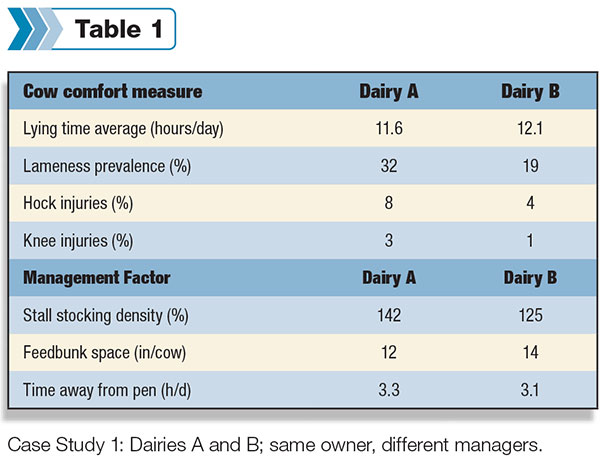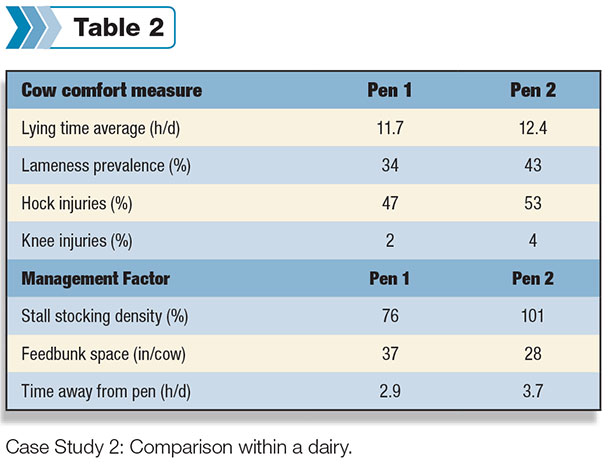Case studies are often the best way to communicate how management and facility factors affect various outcomes on individual dairies. Detailed below are two case studies from dairies in the Midwestern U.S. that act as great examples of how management plays a large role in cow comfort.
When discussing and assessing cow comfort, there are a lot of questions and dialogue that focus on facility design being the major influencer. Although many factors can have a large impact on cow comfort, the Novus C.O.W.S.
Program highlights that management may be the number one influencer. As a comprehensive on-farm assessment and benchmarking program measuring management, facility factors and cow-based measures, the program has highlighted the significant impact of different management factors.
Case study 1: Dairies A and B; same owner, different managers
Assessments were completed and the data compared from two separate milking facilities belonging to the same owner (Table 1). Dairies A and B were run by separate managers at separate locations, and one pen of high-producing, mature cows was assessed at each location.

All of the dry cows were housed and freshened in one location and moved to either Dairy A or B based on space. The two dairies were similar in that both were 3X milking about 3,000 cows.
Cows were fed three times daily and housed on deep-bedded sand stalls cleaned and raked three times each day and pen alleys also cleaned three times each day. Dairies A and B followed the same hoof care regimen with regards to trimming and foot bath frequency. Outlined below are a few key results from the assessments.
Following the data collection and summary, the findings from the assessment, including the data specific to that dairy as well as how it compares to regional benchmarks, are presented to the producer. In this case study, the owner was curious as to why the two dairies differed so much in regards to cow comfort.
Dairies A and B seemed similar enough when looking at their overall facilities and operations, but it wasn’t until the specific differences in management factors were identified that the variation in the outcomes could be understood.
Dairy A had higher stall stocking density, less feedbunk space per cow and the cows spent more time away from their pen for milking compared to Dairy B. As a result of a few varying management factors, these two dairies with the same owner, genetics, feeding routine, bedding, cleaning and grooming routine, had large variations in cow comfort measurements.
Case study 2: A comparison within a dairy
Two separate milking pens, belonging to the same dairy facility and run by the same manager, were assessed and compared (Table 2). Pens 1 and 2 were managed very similarly, with the main difference being the type of stall base.

One pen had mattresses, and the other was deep-bedded. Both pens consisted of about 100 to 130 high-producing, mature cows on 3X milking, fed once per day and bedded with digested manure solids once daily. Displayed below are a few of the measures from the assessments.
Overall, Pen 1 had a lower lying time, lameness and injury prevalence, as well as a lower stocking density and time away from the pen for milking compared to Pen 2.
During the report delivery to the dairy management team, the assumption was that the pen with the more desirable outcomes, Pen 1, was the deep-bedded pen. However, the results actually indicated the opposite. In this scenario, the cows currently housed on mattresses had better comfort.
The answer to why the mattresses seemed to be better than the deep beds was uncovered after the dairy’s team looked at the whole-farm management system and strategy.
The cow manager explained that he understood the benefits of deep beds over mattresses (previous studies have shown beneficial effects of deep beds on lying time, lameness and hock injuries), and he was housing the cows accordingly.
Any cows that were identified as sore, lame or needing special attention in the mattress pen were relocated to the deep-bed pen, hence the resulting higher numbers.
In the end, the overview of management was the key piece that shed light onto why the data initially reflected the deep beds as inferior. This case study highlights that data alone cannot always tell the full story, with the results only making sense after taking management practices and strategies into consideration.
The goal of the program is to provide valuable feedback to producers about cow comfort on their farm, and how it relates to regional benchmarks. In each region, there are dairies with exceptional cow comfort while others are struggling with issues like lameness and leg injuries.
Cow comfort issues and solutions are multi-factorial, often requiring a “1,000-foot view,” looking at the system as a whole, like in Case Study 2, to dissect the herd or pen-specific issues.
Previous research has outlined the effects of facility design and management on cow behavior and comfort; however, even within similar facilities like in Case Study 1, cow comfort can still vary greatly, highlighting the key role of management.
Overall, even small changes in management factors or procedures can have a huge impact on improving cow comfort and a dairy’s bottom line. PD
Katie Wood is a C.O.W.S. project manager with Novus International Inc.
Lindsay Collings is a C.O.W.S. project manager with Novus International Inc. Email Lindsay Collings.





